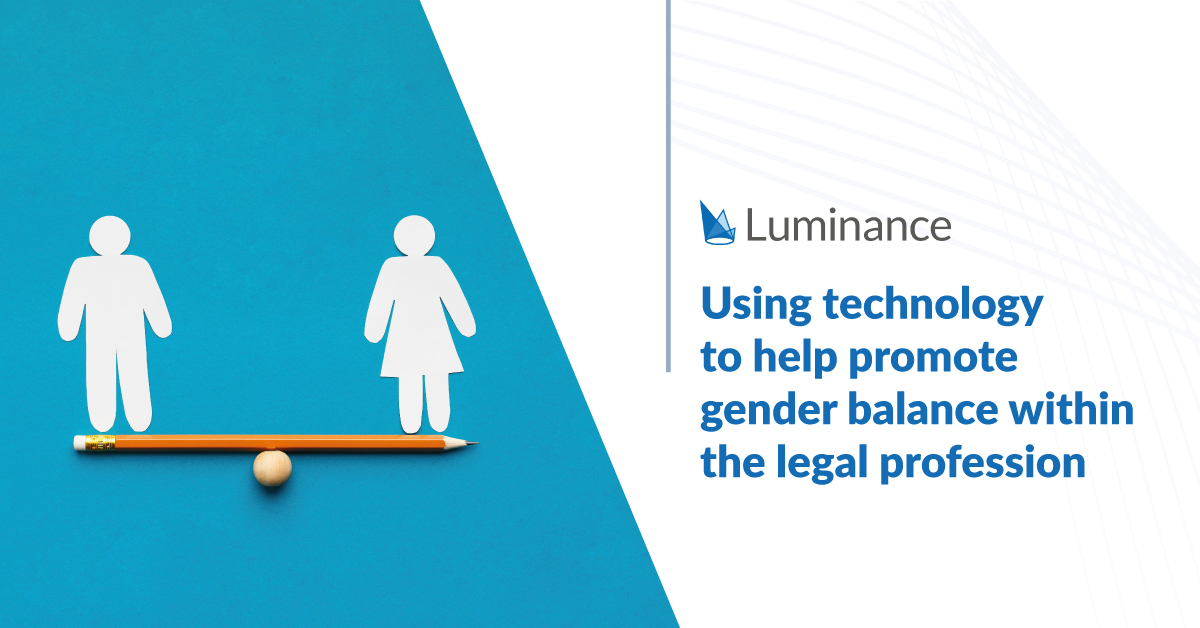
Blog
Using technology to promote gender balance within the legal profession
26 August 2020 | Luminance
The lack of flexible working opportunities is one of the most significant barriers to women in the legal industry, with a recent survey by McKinsey finding that nearly half of women working in law believe that prioritising a work-life balance could jeopardise their success in a firm. Nonetheless, the sudden need to work remotely has resulted in a new found respect for more flexible, agile working practices which has largely been facilitated through increased use of technology. Platforms like Luminance which facilitate collaborative remote working herald real possibilities around the future of working practices, enabling lawyers to do their job effectively from any location - be it their desk in the office or whilst working from home.
The need for greater diversity
Whilst women represent almost two-thirds of lawyers across the profession, a recent study found that at Partner level, the proportion of women drops to 18.5%. Indeed, numerous studies have highlighted the fact that women still spend disproportionately more time on unpaid care work around the home than men; trying to juggle being in the office with home-based demands is just one of the factors that significantly impedes women’s ability to advance and progress to the highest levels during their legal careers.
Until Covid-19 thrust us all into home offices, the legal industry has been a relatively slow adopter of flexible working practices. Research suggests that even those firms that endorsed flexible working policies pre-Covid were still fairly conservative, for instance capping working from home to one or two days a week. Nonetheless, the pandemic has forced many firms to radically overhaul their working practices almost overnight. And, with a growing number of firms stating their support of longer-term remote and flexible working practices, there is an increasing need for innovative tools that support both individuals and firms in their new work environments. Indeed, law firms are increasing looking to technology such as Luminance to form part of the solution, whilst for those lawyers who are balancing home-based responsibilities with job commitments, technologies that can facilitate effective remote working hold huge potential.
Unlike legacy technologies which require weeks- or even months- of system building and installation, Luminance can be deployed rapidly on users’ computers via the cloud, whilst the platform’s intuitive, easy-to-use interface means that lawyers are able to access their files, analyse their data and seamlessly collaborate with their colleagues and clients remotely. To give an example of how Luminance can facilitate collaborative remote working, recently leading London barristers’ chambers, The 36 Group, used Luminance to conduct a historic, high-profile murder investigation. They had a team of 20 experts working on the case, and by using Luminance, the team were able to access a digital dataset consisting of over 10,000 documents almost immediately. With a large team, collaboration was key, and Luminance’s seamless workflow tools such as the ability to allocate documents and tasks and track work progression ensured the team were able to conduct a coordinated and efficient review, despite working from different locations.
Work smarter and retain the best talent
Proven to accelerate document review by up to 100% from day one, Luminance allows lawyers to utilise technology to assist with many of the more repetitive, admin-heavy tasks such as finding missing clauses or tagging key provisions across a document set; instead, lawyers are able to devote more time to higher-level analysis, generating greater job satisfaction and motivation amongst lawyers.
Indeed, with advanced technologies promoting more satisfying work which can be completed flexibly from remote locations, firms can see a real difference in the retention of talented lawyers. A recent study by Timewise found that 91% of women either work flexibly or want to, and firms that invest in systems to promote this are more likely to attract and retain the very best talent. And with more female lawyers remaining in practice, firms will have more opportunities to promote women into senior roles, in turn improving the diversity and culture of the firm.
While the question of a full-time return to the office remains open, there is no doubt that the move towards more flexible working practices and the increased usage of technology is here to stay. Certainly, technology plays a huge role in defining what the modern lawyer looks like and how they conduct their legal practice. Firms that adopt a forward-looking vision, acquiring technology to promote the best working practices for their employees, will no doubt gain a competitive advantage in the hiring and retention of the very best lawyers regardless of their gender, bringing the legal industry one step closer to creating a more inclusive and diverse workplace.